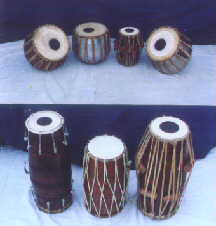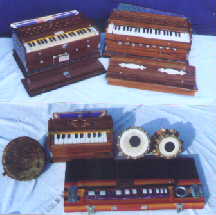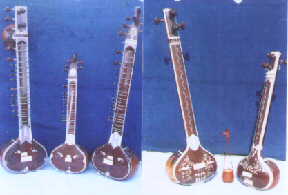
|

|
Compiled by V.S.P. Kurup Mother nature is the origin of all arts, more so of music. In the giggling flow of rivers, in the gentle roll of sea waves, in the swaying of trees and rusling of leaves, in the cooing of birds in spring--everywhere there is music if only one has the ear to listen. The early man with nothing much to occupy his mind started observing these phenomena, each with its specific sound and rhythm. He could see a discernible pattern in all of them and in time this evolved into dance and music. In fact dance is the articulate form of music. In nature, music encompasses everything in a celebration of colour, movement and sound. Songs and its colour equivalent herald all seasonal rhythms: the trees explode into a riot of colours in spring when the cuckoo greets it with a song, the peacock with its enchanting dance hails clouds during the rainy season. Man is no exception in following his musical instincts. He has devised music to suit all occasions:there is music to jubilate birth, rejoice wedding and mourn death; the ploughman cajoles his animals with a song on his lip, the boatman breaks into a melody in midstream, and the shepherd hums away his loneliness. This folk origin has provided immense strength and variety to India's musical culture. Much thinking and effort have gone into, since its hoary origin, to refine it into its present classical tradition invested as it is with perfection, maturity and variety. But this evolution has not been smooth-- it has had its ups and downs in tune with India's social history --but the long chain has been unbroken unlike that of some other countries. Origin It took a long evolution to liberate
the melody completely. For, initially there were only three notes
and they were sung rigidly in a descending order. After a long
period, the evolution helped expand the scale and transform the
sequence from mere scale singing to fascinatingly varied progressions
up and down. Ragas The permutations possible, with all this variability, are very large. But since the selection rule that musical evolution seems to have applied is that the melodic mould should be aesthetically satisfying, the number of ragas is about three hundred of which only about a hundred are common. Several attempts have been made to group the ragas in relation to primaries and derivatives. Rhythmic
Patterns Indian rhythms are apt to be more difficult for foreigners to grasp. This is because a single cycle of rhythm, or bar, can be built out of units of different duration. The total duration for the cycle can be divided in various ways. When the cycles are repeated in the continuous singing or playing, the pattern of accenting may vary even if the total duration of two rhythm-schemes is the same, and the cycle itself may be long. But one clear punctuation for the listening ear is available in the first beat (sam) which is the most emphatic of all the beats in the cycle. Equipped with melody and rhythm, music has undergone a magnificent evolution in India. In its sweep it has united earth and sky. Originating in religious worship, it has become a spiritual discipline. Singing by itself thus becomes a spiritual exploration, in addition to being an aesthetic one. The harmony of pure being and dynamic becoming, of the transcendent and the immanent, of eternity and time, is a fundamental doctrine in the Indian tradition. In the initial elaboration of
the raga as free melody, the singer contemplates the beatitude
of timeless existence; in the later rhythm-bound movements, he
senses the excitement of the rhythm of cosmic evolution. Indian
music has no absolute pitch. For each occasion of singing, a
drone furnishes a frame, a sustained tonal centre. The tonic,
heard continuously before, throughout and at the conclusion of
the singing, expresses the timeless, eternal background of things
. The singing itself is an interlude which builds up tonal space
through Hindustani
and Carnatic Music The dhrupad form of the north, which was first shaped by Raja Mansingh Tomar of Gwalior and developed by Swami Haridas and his disciple Tansen (who was a luminary of Akbar's court), conserves the antique liturgical stateliness in its style. It begins with a free melodic elaboration or alap and goes on to a rhythm-bound lyric whose first two sections traverse progressively the lower, middle and upper octaves while the last two sections can be regarded as the complex development of the same musical material. There are only a few practitioners of this style today. The dhamar is a transitional form pointing in the direction of the further evolution. For, though it is very much like the dhrupad, its lyrics are mostly based on the romantic episodes in the life of Lord Krishna and this in turn has made its style more supple and sensuous, with greater use of gamaks. These qualities of suppleness and sensuousness, with swifter and wider appeal than the gravity, discipline and stateliness of the dhrupad, reach their fullest expression in the kheyal (which means imagination) and the elaboration of the kheyal is decorated with all possible imaginative graces. The structure is considerably relaxed. It is rarely that singing begins with the alap or free melodic elaboration; more often the alap is done in the melodic elaboration of the phrases of the composition itself. There is an extensive exploration of all possible resources of gamak here. The Gharanas The distinction of musical temperaments reflected in these gharanas is not difficult with some exposure in concerts or through recordings which are now plentiful. Each of these gharanas has the vitality of growth to permit individual practitioners, even after generations, to find a personal utterance that rings distinctive though within the frame of the broad stylistic features. Northern
Forms In the sabads or sacred songs of the Sikhs, classicism refrains from too great elaboration and ornamentation so that the meaning of the hymns would be clearly communicated. Songs of this clarity, but romantic in temper, stud the folk epics of the Punjab that tell of the tragic loves of Leila and Majnun or Heer and Ranjha. Muslim and Hindu devotion is facilitated to group singing in the qawals and the abhangs respectively. While the abhang is indigenous to Maharashtra, and the kirtan to Bengal and Orissa, the Bhajan has a greater regional spread , and saintly people of all classes, from Meera who was a princess of Rajasthan to Kabir who was a weaver of Banaras , have enriched this form. Many influences, secular and religious, Persian, Hindu and even European, came together in the creativity of Rabindranath Tagore who composed a very large number of songs that modulate the classical tradition to contemporaneity in feeling and expression. Southern
Forms Lyric and melody had parity in dhrupad: kheyal neglected the lyric somewhat; the kriti restores the parity and develops it through a complex unfolding structure. The pallavi is the opening statement in lower and middle registers, the anupallavi is the elaboration in the middle and upper octaves. It is followed by one or more charanams, developmental sequences tracing complex arabesques over the whole range of registers; the pallavi is repeated like a refrain after every charanam. The bole tans in northern singing are phrases of the lyric sung fast and with complex rhythmic variations. But while these can be introduced anywhere in the composition , the neraval of the south which corresponds to it is effectively used for the climax before the conclusion. Pallavi singing -- an independent form not to be confused with the pallavi of the kriti-- is rather like the kheyal in that there is no full-bodied lyric. A lyrical phrase or sentence is used for elaboration or melodic and rhythmic variations. After full exposition in one raga, the phrase may be developed as a ragamalika or garland of raga. The euphoria of singing, especially rhythmic singing leads to dancing. The tillana of the south, like the tarana of the north, is closely associated with abstract dance. The padams of the south are narrative lyrics that are interpreted by dancers in suggestive attitudes, rhythmic dancing, mimetic gesture and facial expression. In a full-fledged dance drama like Kathakali, swift communication of the dialogue-songs has to be ensured. Therefore the classical style was simplified here. The same challenge persisted and was met by the same type of response when the opera or musical drama and, later, the film emerged. Indian
Musical Instruments
While, in the south, instruments play the major forms as in vocal music, they follow a different pattern in the northern concerts. The recital opens with the alap or the elaboration of the raga melody in slow tempo, by the solo instrument. This quickens to the jode where intricately wrought phrases follow one another in fairly quick succession. Next comes the jhala where the drone strings of the instrument are also used. All the three sections are free renditions without rhythmic punctuation, though the jode and the jhala have a rhythmic feeling. The recital closes with a gat, a structured form with an opening section in the lower and middle registers and a following section that spans the middle and upper octaves. All the technical resources of the instruments are used to build up the fabric of the gat which is first played in a slow tempo and then builds up to a brilliant climax in the fast tempo. Records of Modern Classical Masters Hindustani Vocal Dhrupad: Dagar Brothers Carnatic Vocal M.S. Subbulakshmi, Ariyakkudi, Semmangudi, M.L. Vasanta Kumari, Bala Murali Krishna, D.K. Pattammal, Madurai Mani Iyer, G.N. Balasubramaniam, Jon Higgins Instrumental Sarangi: Ram Narain, Sultan Ahmed Sangeet Natak Akademi's festival,
New Delhi |
Origin |




